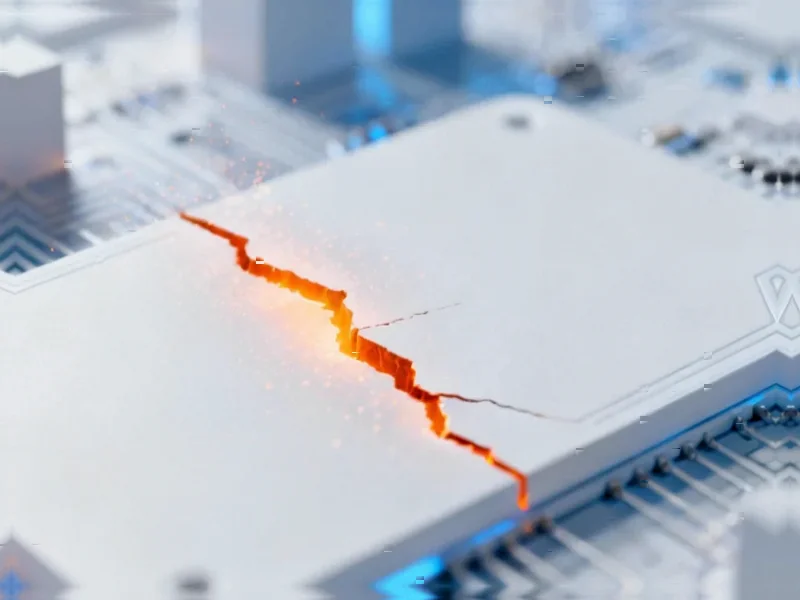TITLE: Manufacturing Cyberattacks Shift from IT Risk to Operational Crisis
META_DESCRIPTION: Major manufacturers face weeks of production shutdowns from cyber incidents as attacks increasingly target operational technology and factory floors.
EXCERPT: Recent cyberattacks against manufacturers like Jaguar Land Rover and Masimo demonstrate how digital threats have evolved from IT problems to full-scale operational crises. With one manufacturer experiencing a five-week production halt, industry experts warn that lean manufacturing operations face existential risks from inadequate cybersecurity. The shift requires manufacturers to treat cyber resilience as a core business priority rather than just a compliance checkbox.
When Factories Stop Running
These days, manufacturing disruptions aren’t coming from mechanical failures or faulty equipment. According to industry analysis, factories are increasingly grinding to a halt because of cyber incidents that target the very systems keeping production lines moving.
Table of Contents
The stakes became painfully clear this year when several major manufacturers found themselves grappling with operational shutdowns. In April, health technology firm Masimo discovered unauthorized network activity that reportedly disrupted facilities and order fulfillment. The following month, steel manufacturer Nucor confirmed unauthorized access to data that temporarily limited certain business functions. Then came the headline-grabber: Jaguar Land Rover faced a staggering five-week production shutdown after an August cyberattack that underscored just how vulnerable modern manufacturing has become.
If billion-dollar manufacturers with substantial resources can be derailed for weeks, analysts suggest this raises serious questions about smaller operations with lean IT and operational technology teams. The message from these incidents appears clear: no factory is immune when cybercriminals come knocking.
Beyond Compliance Checklists
What’s particularly concerning, security experts indicate, is that many manufacturers still approach cybersecurity as a compliance exercise rather than a strategic business imperative. Meeting minimum regulatory requirements might satisfy auditors, but it’s increasingly clear this baseline posture isn’t stopping determined attackers.
The numbers tell a sobering story. According to Verizon’s Data Breach Investigations Report, a staggering 83% of manufacturing breaches involve phishing, system intrusion, or compromised software. These aren’t sophisticated zero-day attacks requiring nation-state resources—they’re exploiting fundamental security gaps that many organizations still haven’t adequately addressed.
Manufacturing leadership teams now face questions that go far beyond technical specifications. How much downtime can their operations realistically absorb? What intellectual property would be catastrophic to lose? These discussions are moving from IT departments to boardrooms as companies recognize that cyber risk has become inseparable from business continuity planning.
The Legacy Technology Trap
Manufacturing environments present unique challenges that many other industries don’t face. Factories often operate with expensive operational technology designed to last decades, not years. While these systems might be fully depreciated on the balance sheet, the practical cost and disruption of replacement frequently delays necessary upgrades.
The result is what security professionals describe as an expanding attack surface. Outdated protocols, unsupported operating systems, and legacy configurations create not just technical headaches but genuine business risks. For smaller manufacturers especially, the calculation becomes increasingly urgent: when does the potential impact of a cyber incident finally outweigh the cost of updating aging technology?
Meanwhile, the nature of modern manufacturing creates additional pressure points. Just-in-time production means minimal inventory buffers, amplifying the impact of any disruption. Extended supply chains mean vulnerabilities in partners can cascade through entire production networks. And valuable intellectual property—from designs to proprietary formulas—represents tempting targets for theft or espionage.
Building Defenses That Work
Security experts suggest manufacturers need to shift from basic prevention to comprehensive resilience. Traditional endpoint protection alone is proving insufficient against determined attackers. Industry analysis points toward integrated approaches like Extended Detection and Response (XDR) that unify visibility across devices, servers, and cloud systems.
For smaller operations with limited resources, combining these technologies with Managed Detection and Response (MDR) services can provide 24/7 monitoring capabilities without requiring massive internal security teams. The goal isn’t just to block attacks but to maintain operational continuity even under pressure.
The business case appears increasingly compelling. According to IBM’s 2024 Cost of a Data Breach report, the average industrial breach costs $5.56 million. But the real damage often comes from stalled production, missed contracts, and eroded customer confidence that can take years to rebuild.
Resilience as Competitive Advantage
What’s emerging across the manufacturing sector is a recognition that cybersecurity can’t be siloed as purely a technical concern. As Tony Anscombe, Chief Security Evangelist for ESET, suggests in his analysis, the smartest factories in the Industry 4.0 era won’t just be the most automated—they’ll need to be the most cyber-resilient.
Leadership teams are now evaluating technology upgrades not just as IT expenses but as strategic investments in business continuity. The conversation has shifted from eliminating risk entirely—an impossible goal—to defining acceptable risk thresholds and building defenses robust enough to keep operations running when attacks inevitably occur.
In manufacturing environments where downtime translates immediately to lost revenue and damaged customer relationships, cyber resilience is quickly becoming as fundamental as quality control or workplace safety. The factories that recognize this reality earliest may find themselves with a significant competitive advantage in an increasingly connected industrial landscape.
Related Articles You May Find Interesting
- Intel Returns to Profitability Amid Government Backing and Restructuring
- Goldman Sachs Explores Petco Debt Refinancing as Retailer’s Health Improves
- Sophisticated Phishing Campaign Targets LastPass Users with Fake Death Claims
- MEmu Android Emulator 9.2.9 Boosts Performance with Key Compatibility Fixes
- Verizon Debuts $25 Monthly Internet Plan Targeting Budget Users



